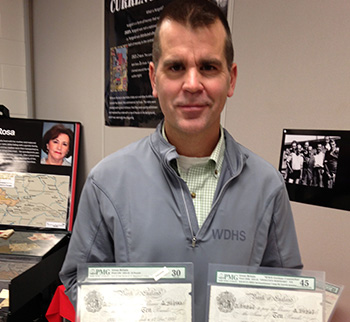HAMILTON — While students often learn about history while visiting a museum, one class at Waterdown District High School created its own.
Members of the school’s genocide class created a museum with a collection of artifacts from World War I, World War II and the Holocaust, the Cold War, the Ukrainian Holodomor and Canada’s residential schools in an exhibit sponsored by the Aboriginal community of Hamilton. It also included displays on 100 years of Canadian armed service (1914-2014) and the 70th anniversary of the liberation of the Netherlands.
Students researched their topics and the items on display, and they acted as guides for visitors to the museum, which opened Oct. 17 and ran until Oct. 31.
“They can read about history. But I want them to be in touch with history. If they actually see the items, history becomes tangible and palpable,” said history teacher Rob Flosman. “If students learn about these items and have to teach about them, they own it. It becomes a part of them.”
The museum, which was in a classroom inside the school, was made possible through donations from community members, including one, a Kyu gunto sword, that was taken from a Japanese soldier during combat.
Jay Keller, who lives in Waterdown, which is part of Hamilton, helped liberate Belgium and the Netherlands during World War II. His medals, attendance record and military ID were on display.
Another local resident, Nadia Rosa, donated her yellow Star of David and the ration cards and bank cards she received as a prisoner at Theresienstadt. Rosa, who was born in Czechoslovakia, had been hiding with a Christian family when she was betrayed by the Gestapo.
The military service medals of Edison Kahgee are also on display. Edison, who was born in 1921, lived at a residential school in Brantford, Ont., from age seven to 16. Native children were sent to one of more than 200 schools across Canada to wipe away their culture and convert them to Christianity. Kahgee became a mechanic and a mechanic in the military. He did not receive his medals or compensation until 2004, after he died.
“We learn about genocide, but it’s unbelievable that this happened in our own backyard,” said student Eric Nanderam, 16.
Student Adam Hinckley, a guide for the items in the World War II exhibit, said many visitors were amazed at the weapons, but he was more interested in the Rolls razor given to British troops during the war; the personal letters home; and the canvas gurney that carried wounded and dead soldiers. He marvelled at the British LDV (local defence volunteers) armband and whistle, which gave ordinary citizens the right to defend against German soldiers.
“These items show a side of the war many didn’t even know existed,” he said. “They show the more human side.”
Many artifacts were provided by local resident Madeleine Levy, who is on the advisory board for Facing History and Ourselves Canada. The organization, along with the Toronto District School Board, developed the Grade 11 genocide course, which is now being implemented in many Ontario school boards. Levy also arranged and sponsored the inclusion of the Operation Bernhard exhibit, which is part of a major collection of the Florence and Laurence Spungen Family Foundation in Chicago.
Operation Bernhard was a plan that included forcing certain prisoners at the Sachsenhausen concentration camp to make counterfeit British currency. The intention was to devalue the pound and collapse the economy. Counterfeit notes were dropped over Britain by aircraft and also used by spies.
